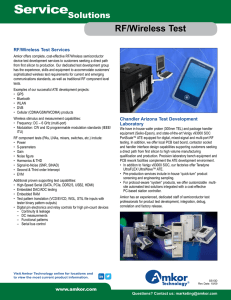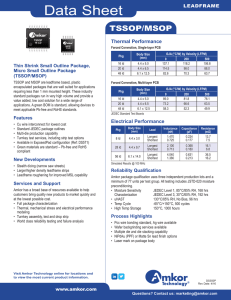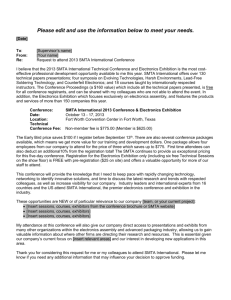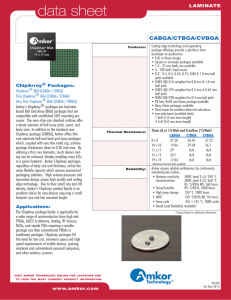Package on Package (PoP) Technology Presentation
advertisement
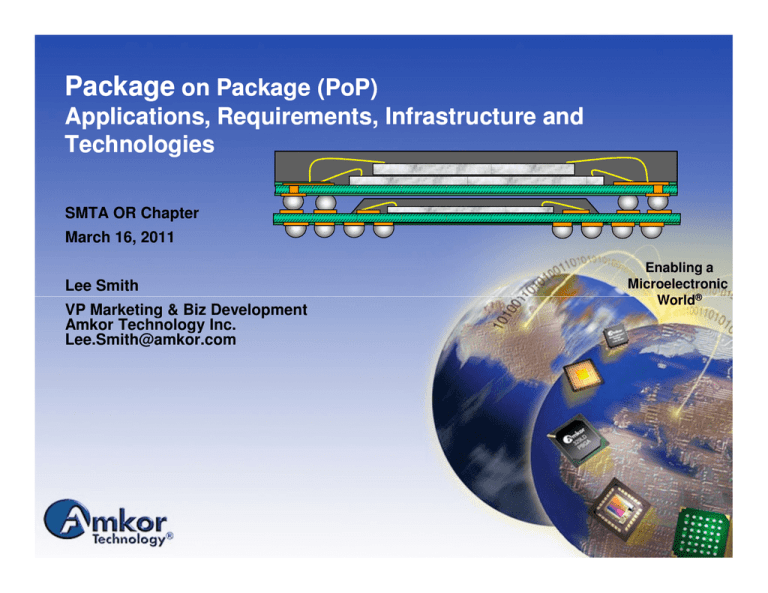
Package on Package (PoP) Applications, Requirements, Infrastructure and Technologies SMTA OR Chapter March 16, 2011 Lee Smith VP Marketing & Biz Development Amkor Technology Inc. Lee.Smith@amkor.com Enabling a Microelectronic World® Outline Background: Application Trends & Requirements for Package Stacking • • • Mobile Handset Requirements Drive to PoP 1st Generation PoP Development / Deployment Summary PoP Infrastructure 1st Generation PoP Technologies • • • Warpage considerations PoP – SMT, and BLR considerations Trends / Requirements for higher density PoP Next Generation PoP Technology • • • PoP with TMV® (Thru Mold Via) Interconnects TMV technology benefits TMV PoP surface mount / brd level reliability studies © 2011 Amkor Technology, Inc. Amkor restricted release to SMTA March 2011, SMTA OR LSMIT Application Specific Packaging Optimize for Size, Integration, Cost / Performance Driven by the need for more I/Os and high performance Driven by the need for small size and low cost 1970s 1980s DIP 1990s PGA 2000s BGA DLP® SiP QFP LCC FBGA / CSP SOP TQFP / FQFP FC TouchChip® SSOP / TSOP 3D Pkg QFN Stacked Die CSP WLCSP Package-on-Package PoP DLP courtesy of Texas Instruments © 2011 Amkor Technology, Inc. Amkor restricted release to SMTA TouchChip courtesy of UPEK March 2011, SMTA OR LSMIT © 2011 Amkor Technology, Inc. Amkor restricted release to SMTA MEMS microphone Cu Pillar Bump fpfcCSP 2010 FCmBGA 2009 2008 FlipStack® CSP 2006 Fusion Quad® TMV® PoP PoP Camera Module Paste Bump etCSP Memory Card SCSP MLF® SiP Vision Pak WLCSP Plated Bump fcCSP FCBGA TABGA uBGA CABGA fleXBGA Super BGA® PBGA 2005 2002 2000 1999 1998 1995 1996 1997 Amkor New Package Intro History (OEM collaboration for apps specifics / infrastructure) March 2011, SMTA OR LSMIT Source: Mario Bolanos “Packaging Trends Applied Research Opptys at U. of Binghampton CAMM © 2011 Amkor Technology, Inc. Amkor restricted release to SMTA March 2011, SMTA OR LSMIT Smartphone Advancements would not have been possible without 3D Pkg and PoP technologies 3D packaging address integration challenges to enable semiconductor advancements . . . . . . to deliver physical world benefits © 2011 Amkor Technology, Inc. Amkor restricted release to SMTA March 2011, SMTA OR LSMIT © 2011 Amkor Technology, Inc. Amkor restricted release to SMTA March 2011, SMTA OR LSMIT 3D Pkg Development – Collaboration ! • 1st Generation 3D (Die Stacking) • Memory IDMs for wirebond combo memory (MCP) were 1st • Followed by outsource or development collaboration w/ SATS • Logic + memory stacking, IDM collaboration with SATS followed by IDM internalization for dual source, Fabless collaboration with SATS • 2nd Generation 3D (Package Stacking or PoP) • Nokia collaboration with Amkor drove technology platform development • OEM / IDMs collaboration with Amkor for PoP product development / deployment • Next Gen PoP (TMV®) Amkor driving – multiple areas of collaboration • 3rd Generation 3DIC w/ TSV • Full supply chain collaboration © 2011 Amkor Technology, Inc. Amkor restricted release to SMTA March 2011, SMTA OR LSMIT Die vs. Package Stack Analysis (Business model’s huge impact on Cost of Ownership) % of Applications 100% PoP 3D SiP (Dominant for Combo Memory & Digital + analog) 0% Vertical Die Qty 2 3 4 5 Cumulative Die Yield High Low Die / Test Costs Low High Require burn-in No Yes Simple Complex Sourcing flexibility No Yes Design flexibility No Yes Die/Memory Sourcing © 2011 Amkor Technology, Inc. Amkor restricted release to SMTA (Dominant for multi-media Apps proc + complex memory stacking) March 2011, SMTA OR LSMIT Amkor 3D Collaboration – Technical Papers • Amkor / Nokia – PoP Joint Industry Tech Papers – – – – • ECTC 2002 Extremely thin BGA / CSP and BLR (etCSP) ECTC 2003 Package stack thin CSP and BLR (PSetCSP) ECTC 2007 High Density PoP Stacking and BLR (PoP w/ SoP) EMPC 2009 Mechanical qualification of TMV® PoP w/ ST Micro Joint Industry Papers on PoP, SCSP and TMV® – – – – – ECTC 2006 PoP Stacking Study vs Warpage – w/ Sharp & Panasonic IMAPS DPC 2006 PoP Stacking & BLR Study – w/ Spansion & Panasonic SMTAI 2008 TMV PoP Stacking & BLR Study – w/ Sony Ericsson IMAPS DPC 2009 High density 8 die stack – w/ Intel SMTAI 2009 TMV PoP Stacking App Notes & BLR – w/ Celestica © 2011 Amkor Technology, Inc. Amkor restricted release to SMTA March 2011, SMTA OR LSMIT 1st Generation PoP Development PSvfBGA Core Technologies from CSP Tool Box Pin gate mold 0.25 to 0.35 mm Low loop wire Thin die Thin die (4~3mil, 1mil D/A) (from SCSP) Low loop wire (from SCSP) Pin gate mold (from etCSP) Package stacking application notes Pb free material set (from SCSP) © 2011 Amkor Technology, Inc. Amkor restricted release to SMTA Advantages Low wire sweep Low mold void Can place the lands around encapsulation area Thin molding March 2011, SMTA OR LSMIT 1st Generation PoP – Infrastructure Development OEMs Architecture stacking 12 major OEMs in Handset and DSC market adopting PoP Industry Standards JEDEC – JC.11.2 Design guide, JC11.11 POD, JC-63 pin outs Equipment Panasonic, Siemens, Fuji, Unovis, Assembléon, Hitachi EMS / ODM 5 major EMS providers in production or development Logic IDM 15 major IDMs adopted PoP Memory IDM 8 major Memory suppliers adopted PoP Amkor Full service – Develop, Design, Model, Standards, bottom, top PoP, Modules, pre-stacked engineering samples, BLR Practical Components – stocks Amkor 12 and 14mm bottom / top DC samples www.amkor.com Design, stacking, test and Brd level reliability (joint study papers) © 2011 Amkor Technology, Inc. Amkor restricted release to SMTA March 2011, SMTA OR LSMIT Bottom PoP (PSvfBGA) Sizing criteria Wire count? Die size? Wiring Density Number of i/o to top package? Number of i/o to motherboard? (bottom side) © 2011 Amkor Technology, Inc. Amkor restricted release to SMTA March 2011, SMTA OR LSMIT 1st Gen. PoP Design Guidelines (Wire bond) - 0.65mm top / 0.5mm bottom A B Body Package Interconnect Size Ball Count Matrix 10 15 104 11 16 112 12 18 128 13 19 136 14 21 152 15 22 160 C D Bottom Side Die Size Ball Count - 300 < 5.5 - 350 < 6.0 - 400 < 7.5 - 450 < 8.0 - 550 < 9.0 - 700 <10.0 Wire Count - 320 - 360 - 420 - 460 - 520 - 560 PSvfBGA, PoP bottom package General guideline based on advanced substrate design rule 0.27mm – 1 die 0.35mm – 2 die For higher I/O count requirements apply 0.4mm ball pitch on bottom © 2011 Amkor Technology, Inc. Amkor restricted release to SMTA March 2011, SMTA OR LSMIT 1st Gen PoP - ball Clearance Sets Stacked I/O Density Multiple variations of pitch and ball size have been successfully paired to accommodate various mold cap or bare FC die heights. Target value for standoff f2 will influence stacking yield and will depend on: • Warpage characteristics of the top and bottom packages • The stacking capability and process of the end assembly house. © 2011 Amkor Technology, Inc. Amkor restricted release to SMTA March 2011, SMTA OR LSMIT JEDEC PoP Standards • JC-11 (Design and Mechanical Outlines) – PoP Design Guide covers top and bottom packages to ensure mechanical integrity. • JC-63 (MCP task group defines memory Pin-outs) PoP 10 to 16mm body sizes approved – 0.65 to 0.4mm pitch memory interfaces © 2011 Amkor Technology, Inc. Amkor restricted release to SMTA March 2011, SMTA OR LSMIT Source: JEDEC © 2011 Amkor Technology, Inc. Amkor restricted release to SMTA March 2011, SMTA OR LSMIT 1st Gen. PoP w/ FC Bare Die • 0.50mm Pitch on Top Side Body Size 10 11 12 13 14 15 Package Interconnect Matrix Ball Count 19 136 21 152 23 168 25 184 27 200 29 216 (unit : mm) Die Size w/o Dam w/ Dam < 5.40 < 6.40 < 6.40 < 7.40 < 7.40 < 8.40 < 8.40 < 9.40 < 9.40 < 10.40 < 10.40 < 11.40 Note) Values subject to change without notice. SM Dam to prevent resin bleed Package size Max die size PoP Ball pads Package interconnect pad © 2011 Amkor Technology, Inc. Amkor restricted release to SMTA March 2011, SMTA OR LSMIT Mobile Phones Finish 2010 Strong Smartphones Drive Growth & PoP Demand Semi TAM ($B) Yr/Yr Growth 2008 2009 2010 2011 2012 2013 2014 2015 CAGR '10-'15 42.7 39.5 49.1 55.8 60.0 61.8 65.6 70.8 7.6% -8.0% -7.5% 24.3% 13.6% 7.6% 2.9% 6.2% 8.0% 1,400 Mobile Phones (Millions of units) 1,200 1,000 800 Smart 31.0% CAGR 600 Enhanced -4.5% CAGR 400 Basic 3.5% CAGR 200 0 2008 2009 2010 2011 2012 2013 2014 2015 Source: Gartner 19 © 2011 Amkor Technology, Inc. Amkor restricted release to SMTA March 2011, SMTA OR LSMIT PoP Warpage, SMT & BLR considerations Enabling a Microelectronic World® PSvfBGA Warpage Considerations Structural CTE Mismatch Bottom Package 25C Shrinks less Cool down Shrinks more expands less Heat up 260C expands more © 2011 Amkor Technology, Inc. Amkor restricted release to SMTA March 2011, SMTA OR LSMIT Design Factors Impacting Warpage • Mold • Die – Die size – Die Thickness • Die attach – Material property – Thickness © 2011 Amkor Technology, Inc. Amkor restricted release to SMTA – Material property – Shrinkage – Thickness • Laminate Substrate – Properties – Thickness – Cu ratio – Routing March 2011, SMTA OR LSMIT JEDEC Standard Warpage Legend and Example Data 150 + Cry 100 50 0 - Smile -50 -100 -150 © 2011 Amkor Technology, Inc. 25'C 75'C 125'C 175'C 225'C 260'C 225'C 175'C 125'C 75'C 25'C sample 1 30 -36 -45 -70 -92 -79 -92 -70 -45 -32 52 sample 2 37 -47 -37 -65 -88 -74 -88 -65 -37 -40 73 sample 3 41 -32 -33 -54 -81 -76 -81 -54 -33 -30 73 sample 4 30 -40 -45 -68 -92 -72 -92 -68 -45 -36 64 sample 5 37 -30 -34 -59 -87 -71 -87 -59 -34 -47 66 Amkor restricted release to SMTA March 2011, SMTA OR LSMIT Recommendations for improving SMT and Stacking yield • Warpage data processing methods A B Package corner to package corner Array corner to array corner C D Inner and outer corners of ball matrix (diagonal) Ball matrix corner to corner (sides) • Appropriate methods Use Methods C&D Top Pkg Bot Pkg Top Pkg Bot Pkg © 2011 Amkor Technology, Inc. Use Methods B*, C & D Amkor restricted release to SMTA * Method B to check for interference of warped packages at the center March 2011, SMTA OR LSMIT PoP Stacking SMT Lines Options Source: Panasonic Factory Solutions and Nokia – KGD Workshop Sept 2006 © 2011 Amkor Technology, Inc. Amkor restricted release to SMTA March 2011, SMTA OR LSMIT © 2011 Amkor Technology, Inc. Amkor restricted release to SMTA March 2011, SMTA OR LSMIT © 2011 Amkor Technology, Inc. Amkor restricted release to SMTA March 2011, SMTA OR LSMIT 14mm PoP Pb-Free BLR Study IMAPS DPC 2007 w/ Spansion * Pad finish of bottom package Leg # Pad finish of Top Package Solder ball Solder ball Top pkg Top side Bottom side Bottom pkg Leg 1 NiAu SAC405 NiAu NiAu SAC305 N/A Leg 2 NiAu SAC405 CuOSP CuOSP SAC305 N/A Multiple reflow passes by Panasonic to simulate prestack Leg 3 NiAu SAC405 CuOSP CuOSP SAC305 Leg 4 NiAu SAC405 NiAu CuOSP SAC305 Leg 5 NiAu SAC405 NiAu CuOSP LFA3 Comment Top pkg substrate Bottom pkg substrate PWB In all cases CuOSP finish JEDEC Drop Boards used © 2011 Amkor Technology, Inc. Amkor restricted release to SMTA March 2011, SMTA OR LSMIT 14mm PoP JEDEC Drop Test Summary (Results for group 2 stress level – see next sheet) – NiAu pad on bottom BGA – IMC crack Cu OSP finish on bottom BGA improves life by 2.6X – Legs 2, 3 & 4 Alternate Ni doped solder ball alloy greatly improves drop reliability 99.0 Cumulative % Failed Leg 1 showed the worst performance as predicted Weibull Leg 1 90.0 W2 RRX - SRM MED F=11 / S=5 Leg 2_3 50.0 W2 RRX - SRM MED F=16 / S=16 Leg 4 10.0 W2 RRX - SRM MED 5.0 F=5 / S=11 – Leg 5 – No failures, robust IMC layers 1.0 Failure Interface same on all legs 1.0 Failure Criteria © 2011 Amkor Technology, Inc. 100.0 1000.0 Drops to Failure – Bottom side of bottom package – Any intermittent discontinuity of resistance greater than 1,000 ohms lasting for 1 microsecond or longer. The first event of intermittent discontinuity followed by 3 additional such events 5 subsequent drops 10.0 Leg # Pad finish of bottom package 1 2&3 4 Top side NiAu CuOSP NiAu 5 NiAu Amkor restricted release to SMTA Solder ball Bottom side Bottom pkg NiAu SAC305 CuOSP SAC305 CuOSP SAC305 CuOSP LFA3 1st Failure Char. Life # of drops 1 50 29 128 16 411 No No Failure Failure March 2011, SMTA OR LSMIT ECTC 2007 Amkor Study for PoP 2nd Level Underfill 14 x 14mm PoP 0.65mm 152 top 0.5mm 353 bottom Control (Non-Underfill) Full Underfill Full DOE Matrix -UF Patterns -Reworkable -Non reworkable Corner Dot © 2011 Amkor Technology, Inc. Amkor restricted release to SMTA Corner L March 2011, SMTA OR LSMIT Next Generation PoP Requirements and Solution Enabling a Microelectronic World® Device Dynamics Packaging System Dynamics Challenges Next Gen PoP: Increased - Integration, Miniaturization, Performance & Collaboration Signal processing µP integration Bband + applications - increased pin counts µP core speed 2 – 3X w/ each node (1GHz @ 45nm) Transition to FC accelerates from 65nm Memory Interface Higher speed memory interface SDRAM – DDR –> LP DDR2 Wider memory bus 16 – 32 Shared to split bus to (2 channel) architectures Increased pin counts with size reduction requires 0.4mm pitch top and bottom Warpage control with thinner / higher density PoP stacks Signal integrity optimization, decoupling cap integration Power efficiency and thermal mngmt Si / pkg co-design for PoP to optimize for cost / performance Processor I/O CMOS Node Peak Power Ave. Die Size 400 65nm 400mW 64mm² 2008 © 2011 Amkor Technology, Inc. Amkor restricted release to SMTA 600 45nm 800mW 50mm² 2010 800 28nm 1.2 W 50mm² 2012 March 2011, SMTA OR LSMIT 1st Gen PoP Technologies limit PoP I/O and Bottom Stacked Die Density – Requiring New Technology • Die stacking in bottom package requires thicker mold cap • New memory architectures require higher I/O interfaces • Higher Semiconductor density requires package size reduction • Thin form factors and increased battery size require thinner PoP stacks • Improved warpage control required when go thinner with higher density • A new bottom PoP technology is needed to continue growth 0.50mm pitch © 2011 Amkor Technology, Inc. Multiple die in bottom package Amkor restricted release to SMTA March 2011, SMTA OR LSMIT Thru Mold Via Technology (TMV®) • Enabling technology for next generation PoP reqmts – – – – – Improves warpage control and PoP thickness reduction TMV removes bottlenecks for fine pitch memory interfaces Increases die to package size ratio (30%) Improves fine pitch board level reliability Supports Wirebond, FC, stacked die and passive integration © 2011 Amkor Technology, Inc. Amkor restricted release to SMTA March 2011, SMTA OR LSMIT What is TMV® (Thru Mold Via) Technology? • TMV is an ablation method to allow solderable connections thru a mold cap. • TMV applies to wirebond, stacked die, flip chip devices (both area array solder and fine pitch CuPillar) and packages with discrete components embedded. TMV could also be applied to FlipStack® (combo FC+WB) and FC w/ TSV stacks. 1st Amkor Tech Paper ECTC 2008 Via size is controlled to minimize gap between top & bottom packages after stacking © 2011 Amkor Technology, Inc. Amkor restricted release to SMTA March 2011, SMTA OR LSMIT TMV® Memory Interface Scaling Benefit © 2011 Amkor Technology, Inc. Amkor restricted release to SMTA March 2011, SMTA OR LSMIT TMV PoP Warpage Improvement 14mm 620 Package Warpage Comparison 250 warpage (um) 200 150 0.2mm thick substrate 100 TMV® PoP +: crying 50 temperature (C) 0 -50 25 150 183 220 230 245 260 245 230 220 183 150 25 -: smiling -100 -150 fcPoP -200 -250 Source: SMTAI 2008 Paper w/ Sony Ericsson © 2011 Amkor Technology, Inc. Amkor restricted release to SMTA March 2011, SMTA OR LSMIT TMV® Interface Pitch Considerations • 0.5mm TMV pitch – 12mm 168 2 row In HVM with 0.35mm mold cap (2+0 wirebond stack) – 14mm 240 3 row In HVM with 0.28mm mold cap (single die FC die) • 0.4mm TMV pitch – In HVM with 0.25mm mold cap (single die FC) • TMV solder ball size and hole size is selected for SMT yield while avoiding solder bridging © 2011 Amkor Technology, Inc. Amkor restricted release to SMTA March 2011, SMTA OR LSMIT Media Tablets, 1Q11 Update: The Next Killer Application (increased 3D Density) Semis($B) 2010 2011 2012 2013 2014 2015 CAGR '10-'15 2.1 6.7 9.8 13.3 16.4 19.1 55.4% Yr/Yr Growth 218% 46.0% 36.6% 23.1% 16.1% 300 Media Tablet Production (Millions of Units) maturity leaves Apple ahead of competitors • Operating systems morphing into ecosystem plays • OS and hardware evolution will 250 make Media Tablets a more viable PC alternative in some cases Long-term: Displace about 10% of mobile PC sales 200 150 • iPad 2 & rival prices and time-to- • Consumer enthusiasm for alternative mobile devices leading to strong uptake of media tablets • Will slow mobile PC adoption in Media Tablet Units 67.1% CAGR ‘10-’15 mature markets as households forgo additional mobile PC buys 100 • Even in the professional market, media tablets are being considered, delaying some PC replacements. 50 0 2010 2011 2012 2013 2014 2015 Source: Gartner 39 © 2011 Amkor Technology, Inc. Amkor restricted release to SMTA March 2011, SMTA OR LSMIT TMV® PoP Design Guidelines - 0.40mm top / 0.4mm bottom A B (Package Interconnect, 2 row) C D* Body Size Matrix Ball count Bottom side ball count (full matrix) Max. Die Size (F/C) Max. Die Size (WB) 10 23 168 529 7.45 6.05 11 26 192 676 8.65 7.25 12 28 208 784 9.45 8.05 12 29 216 841 9.85 8.45 13 31 232 961 10.65 9.25 Footprint-top (B) Package Size (A) Max. die size (D) 0.250.40mm Footprint-bottom (C) ** : illustration only for TMV WB type © 2011 Amkor Technology, Inc. Amkor restricted release to SMTA March 2011, SMTA OR LSMIT TMV® PoP chip cap assy from SMTAI 2008 joint paper 01005 resistor : 400 * 200 * 130 um (X * Y * Z) Screen printing 01005 0 ohm resistors NSMD Chip mounting Reflow TMV substrate after SMT < FC attach SMT process Note: 01005 resistors are thinner than caps © 2011 Amkor Technology, Inc. Amkor restricted release to SMTA March 2011, SMTA OR LSMIT TMV® PoP SMT Summary • Single pass reflow enables optimum logistics Print Solder Paste on Board Pick & Place Bottom Package (TMV) Flux / Paste Dip Top Package Pick & Place Top Package on Bottom Package (TMV) Reflow • Surface mount trials at Amkor with 12x12mm 168 ball 0.5mm pitch PoP interface (ref. slide 8), using following parameters resulted in 100% yield (about 25K units, 20 lots) – – – – SMT stacking material (flux) Flux volume SMT Equipment Bake condition prior to SMT : Senju 529D-1 : 250um dip depth : Assembleon D9 : 125’C 8HR N2 condition • Process studies required for different flux or paste material and dip depth © 2011 Amkor Technology, Inc. Amkor restricted release to SMTA March 2011, SMTA OR LSMIT TMV ®PoP First Pass SMT Yield – Amkor Trials • Dippable flux: Senju Deltalux 529D-1 • Air reflow, 242C Peak • Sample size: 47 lots, ~50K units 100.00% 98.00% 96.00% 94.00% © 2011 Amkor Technology, Inc. Lot47 Lot45 Lot43 Lot41 Lot39 Lot37 Lot35 Lot33 Lot31 Lot29 Lot27 Lot25 Lot23 Lot21 Reference: IMAPS DPC 2010 Lot19 Lot17 Lot15 Lot13 Lot9 Lot7 Lot5 Lot3 Lot1 92.00% Lot11 Paste & Small Via Amkor restricted release to SMTA March 2011, SMTA OR LSMIT Recommendations for improving TMV® PoP SMT Stacking yield • Reflow Good Joint – Reflow peak temperature: 235 – 245C, Time above Liquidus: 45 – 75 sec – Avoid long soak time at flux activation temperature, excessive soak time results in flux burn off/dry off causing Head-in-Pillow joints for top to bottom package interconnects: – Recommendation: Choose flux with recommended pre-heat time of 60 to 75C between 150 – 180C Non-wet Flux 180’C Temp Short preheat Long prehea t Dried flux 150’C 0 62 Time (sec) 110 • Additional Recommendations – Process development on flux or paste material and dip depth – Increasing top package ball size to compensate for excessive warpage of top package © 2011 Amkor Technology, Inc. Amkor restricted release to SMTA March 2011, SMTA OR LSMIT TMV® PoP Board Level Reliability Studies • Package and Board Details – Via sizes for Bottom Package: Small and Large – Board Thickness: 1.0mm – Board Pad size: 0.28mm NSMD • Board Level Temperature Cycling – -40<>125C, 2 cycles per hour – 5000+ cycles completed, NO FAILURE • Board Level Drop Test (Nokia Condition) Critical Locations © 2011 Amkor Technology, Inc. Small Via Large Via 1st failure 72 70 Mean life 147.4 205.3 Characteristic life 160.9 230.9 Slope 4.815 2.676 Amkor restricted release to SMTA March 2011, SMTA OR LSMIT TMV® PoP Board Level Reliability Results • Drop Data (Failures in Bottom package to board interconnects only) – Bottom packages with Small or Large TMVs exceed reliability requirements of no failures in 30 drops at 5% failure rate Weibull Small Via Cumulative % Failed 90.0 Small Via F=32 / S=0 Large Via 50.0 F=32 / S=0 10.0 Large Via 5.0 90.0 Cumulative % Failed 99.0 – Reliability improves with No Connect corner balls Functional corner joints No Connect corner joints. 1st failure @ 70 drops 1st Failure @ 92 drops 99.0 Small Via 50.0 Weibull Small Via F=24 / S=8 Large Via F=32 / S=0 10.0 Large Via 5.0 1.0 1.0 10.0 100.0 10.0 1000.0 © 2011 Amkor Technology, Inc. 1000.0 Drops to Failure Drops to Failure β1=4.8147, η1=160.8986, ρ=0.9946 β2=2.6758, η2=230.8885, ρ=0.9888 100.0 β1=5.0442, η1=187.9451, ρ=0.9658 β2=2.8816, η2=303.3530, ρ=0.9904 Amkor restricted release to SMTA March 2011, SMTA OR LSMIT Summary • ~ 325million PoP components shipped in 2010 up from < 5 million in 2005. Forecasted to grow at same high rate as Smartphones • DDR2 2 channel and other new memory architectures driving higher density PoP memory interfaces • Amkor pioneered 1st Generation PoP (PSvfBGA) and now leading in Next Gen high density PoP with TMV® technology shipping in HVM • One pass SMT PoP stacking enables optimization of supply / logistics and lowest total cost of ownership • Amkor and Universal Instruments planning 14mm 620 / 200 TMV PoP SMT stacking study and industry report to facilitate SMT yield / quality optimization © 2011 Amkor Technology, Inc. Amkor restricted release to SMTA March 2011, SMTA OR LSMIT
